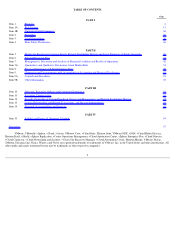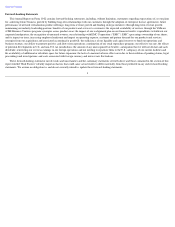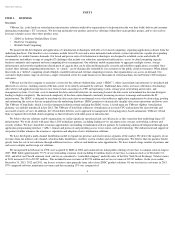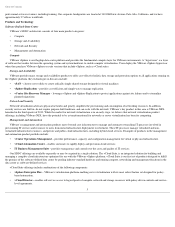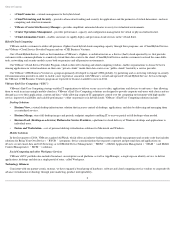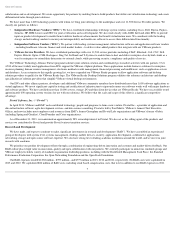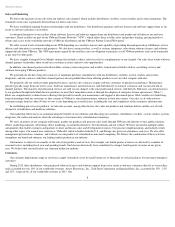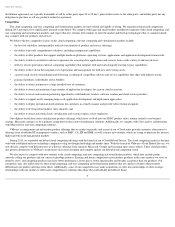VMware 2013 Annual Report Download - page 14
Download and view the complete annual report
Please find page 14 of the 2013 VMware annual report below. You can navigate through the pages in the report by either clicking on the pages listed below, or by using the keyword search tool below to find specific information within the annual report.
Table of Contents
Also, as more and more businesses achieve the virtualization of their data centers and other IT functions, the market for our VMware vSphere product
line may become saturated. If we fail to introduce compelling new features in future upgrades to our VMware vSphere product line, develop new applications
for our virtualization technology or provide product suites based on the VMware vSphere platform that address customer requirements for integration,
automation and management of their IT systems, demand for VMware vSphere may decline.
Due to our product concentration, our business, financial condition, results of operations, and cash flows would therefore be adversely affected by a
decline in demand for our data center virtualization products.
Our new product and technology initiatives subject us to additional business, legal and competitive risks.
Over the last several years, we have introduced new product and technology initiatives that aim to leverage our virtualization infrastructure software
products into the emerging areas of cloud computing and end-user computing as alternatives to the provisioning of physical computing resources.
One of VMware’s core strategies is to deliver the software-defined data center. In 2010, we introduced the first of our vCenter and vCloud products,
which we combined in 2011 with our vShield security product line to create our new Cloud Infrastructure and Management (“CIM”) Suite offering. In 2012,
we delivered the vCloud Suite, which delivers a comprehensive suite for cloud computing in a single SKU with simplified licensing.
In 2012, we acquired two companies that furthered VMware’s SDDC strategy; Dynamic Ops, a provider of cloud automation solutions that enable
provisioning and management of IT services across heterogeneous environments, and Nicira, a developer of software-defined networking and a leader in
network virtualization for open source initiatives. In 2013, we acquired Virsto Software, a developer of software that optimizes storage performance and
utilization in virtual environments.
We also continue to expand and enhance our end-user computing offerings, such as VMware View and Horizon Suite, a solution that provides end users
with a single place to get access to their applications, data and desktops and gives IT a single management console to manage entitlements, policies and
security. In 2012, we acquired Wanova, a leading provider of intelligent desktop solutions that centralize and simplify the management of physical desktop
images while enabling users to take advantage of the native performance of a PC. In 2013, we acquired Desktone, a leader in the Desktop-as-a-Service space.
In the first quarter of 2014, we acquired AirWatch, a leader in enterprise mobile management.
In the second quarter of 2013, we introduced our hybrid cloud service called vCloud Hybrid Service. vCloud Hybrid Service is designed to deliver a
public cloud as a service offering that is interoperable with our customers’
existing VMware virtualized infrastructure, enabling customers to extend the same
skills, tools, networking and security models across both on-premise and off-premise environments. We are currently making significant investments in
developing and introducing new technologies and product offerings related to our SDDC, vCloud Hybrid Service and end user and mobile computing
initiatives.
The expansion of our offerings to deliver the SDDC, address IT management and automation, and enhance our end-user computing capabilities and our
hybrid cloud offerings subjects us to additional risks, such as the following:
12
• technological change that we are unable to address with our data center virtualization products or that changes the way enterprises utilize our
products; and
•
general economic conditions.
•
These initiatives may present new and difficult technological challenges. Significant investments will be required to acquire and develop solutions to
those challenges. Customers may choose not to adopt our new product or service offerings and we may be unable to recoup or realize a reasonable
return on our investments.
• Some of our new initiatives are hosted by third parties whom we do not control but whose failure to prevent service disruptions, or other failures or
breaches may require us to issue credits or refunds or indemnify or otherwise be liable to customers or third parties for damages that may occur. Any
transition of our services from a third party hosting service to our own data centers would also entail a risk of service disruption during a transition.
We may be subject to claims if customers of these service offerings experience service disruptions or failures, security breaches, data losses or other
quality issues.
• The success of these new offerings depends upon the cooperation of hardware, software and cloud hosting vendors to ensure interoperability with
our products and offer compatible products and services to end users. If we are unable to obtain such cooperation, it may be difficult and more costly
for us to achieve functionality and service levels that would make our new products and services attractive to end users.
• We will need to develop and implement appropriate go-to-market strategies and train our sales force in order to effectively market offerings in
product categories in which we may have less experience than our competitors. Accordingly, end users could choose competing products and
services over ours, even if such offerings are less advanced than ours.


